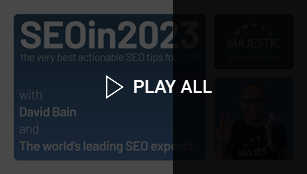All-around search intent
Jessica Maloney
Jess Maloney believes that all-around search intent will be more important than ever in 2023 and that understanding what your users actually want is the key to creating successful websites.

All-around search intent
Jess says: “The Google helpful content update wasn’t really anything new, most SEOs were already doing everything that falls under the update. Not many have been hit terribly. Google is putting out these updates and sharing that it’s really important to focus on the user more than the search engine. This will play into making sure you’re getting the right search intent for the right users and how you’re going to rank because of that.”
How do you define search intent? Is it thinking about the intention behind someone typing a keyword into Google?
“Yes, absolutely. There are typically four kinds of search intents that everyone typically focuses on: navigational, commercial, transactional, and informational. There’s going to be a lot more nuance around that though. While everyone has been focused on these four previously, next year we’re going to have to take a deep dive into these to determine what people are searching for.
For example, if someone is looking for a website with navigational intent or commercial intent looking for a certain brand, are they actually looking for that website or are they looking for a review of that brand? They might be looking at where they can find something in the store. There will be a lot more nuance to these intents that we’ve perhaps never considered before.”
Is it reasonable to ask a tool to automatically categorise intent or should intent be categorised on a manual basis?
“Tools can be helpful but there’s not really an exact way that they can know. There are lots of tools that do this - like Semrush, Moz, etc. They provide this intent for users, but when you drill down and look at them it’ll be different from when you look at things manually. Always look at intent manually and not only at what the search engine is presenting. Use a bit of common sense and logic to determine what people are searching for when they enter a search query.”
With informational intent, do people have a brand in mind or just a general query in mind?
“Informational is typically for people who are searching for ‘who’, ‘what’, ‘where’, ‘why’, and ‘how’ question-based inquiries.”
What about commercial intent? What does that mean?
“Commercial has a lot to do with the different brands and searching for something within that brand. So, looking for something branded and where you can find those certain brands. Whether that’s Nike within a different kind of store or something like that.”
What is transactional intent?
“Transactional is about the kind of people who are wanting to buy something. They are at the buying stage of that funnel - whether they’re looking for the best price or where to buy certain things. They’re at that stage when they’re ready to make a purchase.”
Is the next step to map content to fulfil exactly what people are looking for? How do you decide on what content to write for a particular search query?
“When looking on a query-by-query basis, people commonly look at what Google is presenting as the result. Google typically thinks that people who are searching for something are targeted with a certain intent, and most people will begin to write content for that intent. This is a great way to see what Google thinks that intent is so it’s a great way to go.
One thing that people haven’t considered is the format of the content that’s being created. For example, if you wanted to make content about how to make a chicken soup, you could go to Google and see the top result is a YouTube video. Traditionally you’d see that and think you need to make a video to target this, but that wouldn’t be considering all users. Maybe 50% of people want to watch a video to learn how to make soup, but that wouldn’t be considering the other 50% of people who like to learn by reading. Consider making multiple pieces of content in different formats, whether that’s videos or blogs to target different users within that same intent.”
If you were to do that, would you want to incorporate different forms of content on the same page or publish it on different pages?
“It takes a lot of learning, but sometimes one page might not suffice. It could be that you create a video and add a transcription of that video and that covers all bases. Alternatively, you might create multiple pieces of content and have a hub around that topic.”
How does Google go about determining that you have satisfied the intent of the user?
“There’s not really a true answer to this because Google is just using an algorithm. They don’t fully know if you are satisfying the intent. What they’re looking at is how people interact with the website, and website owners need to consider how the search intent is being hit as well. You can look at things like engagement stats, whether they are spending time on the site, whether they’re finding what they need straight away, or whether they’re bouncing. More onus should be on the website owners than on Google because it’s just an algorithm.”
Can certain queries just require a quick answer and the user could be satisfied within five seconds of visiting a site?
“Absolutely. A lot of this plays into the stuff about no-click searches, where websites now have to make sure they are getting clicks through and satisfying that search intent. Encouraging the click is key because a lot of what people can get from the Google SERP is all they need. It’s about giving them a little bit and enticing them to explore for more.”
Can it be an SEO win if the answer from your site appears directly on the SERP and the user is satisfied with that?
“It depends on what kind of website it is. If you’re looking for brand awareness and you want your name out there, that’ll be great because people will remember your site and hopefully come back. If you’re at the stage where you want people to click through and do something on the site, it can be an issue if you’re not getting the clicks because you’re not targeting the keywords with the right intent.”
If you are targeting those kinds of phrases and intents, how do you measure the success of that if you’ve got a fairly long sales funnel? Should you accept that visitors are worth X amount or is there a better way of defining the value of early-stage intent?
“You can track the brand search interest. If it’s not a big brand that everyone has heard of, you can drive content to get that top-of-funnel stuff. You can start to track search interest in their branded terms. You can see how their impressions are growing and use Google Trends to see how that is changing over time. You can also start to look at repeat users and what they’re doing, when people are coming back (whether that’s through organic or direct), and what’s the next stage. It’s all about tracking the user journey in these situations and seeing if users are landing on the content straight away. Then, further down the line, you can track them and come back to what they’re doing.”
Is it best to focus on commercial and transactional keywords initially - bottom-of-funnel phrases - or should you work on all stages of intent at the same time?
“It’s worth considering everything and considering all kinds of stages. With the bottom-of-funnel stuff, it’ll be a much longer turnaround to start driving leads. If you’re working with a client, they’re not going to be happy with just clicks from the get-go. You’ll want to show them some form of valuable results.
Take a holistic approach across the board from an early stage. You should split out content in the early stages across the four areas. If you start testing early on, you can start to see what kind of content is working well for your brand and what isn’t. You can also look at the user journey from the different types of content and use that to inform the rest of your content strategy.”
Are you seeing any trends in terms of what type of content Google is more likely to serve up for different stages of intent?
“It depends massively on the different areas. A lot of it is definitely focused on the user. When you’re looking at long-tail terms, it’s more specific and you’re getting more in-depth content appearing. When you’re looking at the top-level stuff (the short-tail keywords that are typically harder to rank for), you’ll find more general stuff. It depends on how long the keyword is and how detailed the user search is. This will dictate how detailed the answers are or how general and top-level the answers are.”
What shouldn’t SEOs be doing in2023? What’s seductive in terms of time, but ultimately counterproductive?
“Stop focusing heavily on algorithm updates. When an algorithm update hits and you notice a negative impact on your website, it’s easy to focus on this without another care in the world. It’s important not to solely focus on what’s happened and instead try to fix things.
With all the different algorithm updates, once you’ve been hit you can’t really resolve that drop quickly. You need to make sure you’re doing best practices all around. You could spend time trying to figure out why something has happened, but you’ll never know because Google will never give you the full results. You could spend a lot of time focusing on this when it could be better spent making sure you’re hitting best practice across the board.”
Jess Maloney is an SEO Partner at Open Partners and you can find her over at open.partners.
Choose Your Own Learning Style
 Video
Video
If you like to get up-close with your favourite SEO experts, these one-to-one interviews might just be for you.
Watch all of our episodes, FREE, on our dedicated SEO in 2023 playlist.
 Podcast
Podcast
Maybe you are more of a listener than a watcher, or prefer to learn while you commute.
SEO in 2023 is available now via all the usual podcast platforms
Don't miss out
Opt-in to receive email updates.
It's the fastest way to find out more about SEO in 2024.
欢迎您对此页面提出改进意见。请告诉我们






